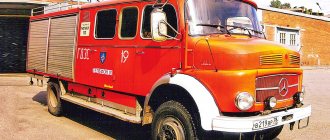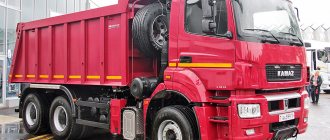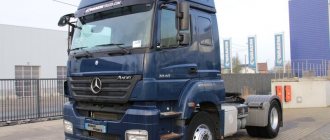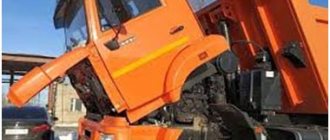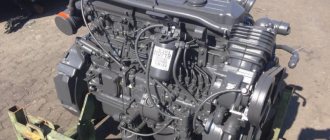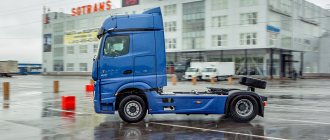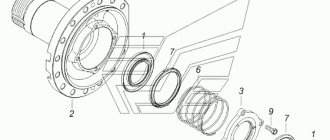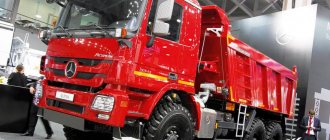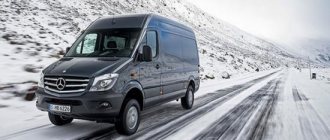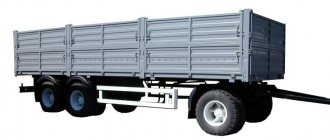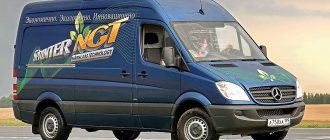KamAZ-5490 is a new series of Russian trucks with a German engine and a cab, created according to the drawings of the Mercedes Benz Axor 2001 model year. KamAZ-Mercedes is equipped with foreign gearboxes, axles and electronics.
KamAZ 5490 is a long-haul tractor that is used for transporting goods over long distances. The updated cabin with two berths is a big advantage over similar models, because allows you to make the work process more comfortable.
Powered by a Mercedes Euro 5 turbocharged engine, the new truck has become even more reliable. The 16-speed ZF gearbox makes fuel consumption even more economical. KamAZ 5490 also has cruise control, which provides speed monitoring and regulation on certain sections of the road without driver participation.
This car has excellent performance characteristics and quite impressive dimensions: length - 6.1 meters, cabin height - 3.3-3.7 meters, width - 2.5 meters (excluding mirrors), total weight of the road train - 44 tons. The wheel arrangement is 4x2, rear-wheel drive, and also has a differential lock.
Which models are included
The Mercedes Benz engine and cab are installed on the following models and modifications:
- KamAZ-5490 is the basic model of a truck tractor with a saddle load of 10.5 tons.
- KamAZ-65206 is a long-haul tractor with a semi-trailer and a saddle load of 16.6 tons.
- KamAZ-65207 is a flatbed truck with a load capacity of 15 tons and a max. trailer weight 14 tons.
- KamAZ-6580 is a dump truck with a 6x4 wheel arrangement.
- KamAZ-65801 is a dump truck with an 8x4 wheel arrangement.
- KamAZ-65802 is a dump truck with a 6x6 wheel arrangement.
Oksana Karakhova, DAIMLER KAMAZ RUS: we produce equipment of the same quality as in Germany
K: 20,000 Mercedes and Fuso trucks in seven years – is that a lot or a little? How does this number coincide with the plans that were at the very beginning of the project?
O.K.: We are a young company that started operating in 2010, and 20,000 trucks in 7 years is a very good indicator, especially if we consider it a good foundation for future development. Of course, the crisis surges affected the figures. Without them, as well as a serious downturn in the commercial vehicle market, this figure could have been higher.
However, we have our own strategic goals for market share and profitability, and we must implement these plans. We are constantly increasing our share, and positive growth trends are observed every year. We started with 10% of the market. At the moment our share is more than 20%. And if we count on improvements in the Russian economy, our development will become faster and more significant. We are all players in the same market - this is the market of European brands of commercial equipment. And we all have certain goals and ambitions, but there are also boundaries.
In the photo: Mercedes-Benz Actros '2011–present.
K: What is the structure of the company’s business, what part is local production, and what part is imported?
O.K.: When we launched production in 2010, we planned that the products produced would make up about 70% of the company’s turnover, that is, 70% is produced in Naberezhnye Chelny, 30% is imported from Germany. In the first year of launching production, we had to actually convince customers of the quality of Russian-assembled trucks, which fully comply with high European standards.
It is now clear to everyone that we produce equipment of exactly the same high quality as in Germany (if we are talking about the Mercedes-Benz brand) and in Japan (if we are talking about the Fuso brand). We are systematically reducing the share of imports. Now the share of MB trucks produced in Naberezhnye Chelny is 75%, FUSO - 100%.
K: Tell me, is the Unimog line imported, or is there local production?
O.K.: We can produce Unimog trucks at the plant in Naberezhnye Chelny, and the buyer can order assembly from us. We can also bring a car from Germany for the client. It all depends on the configuration and attachments. The Unimog is a unique machine with exceptional capabilities. Interestingly, we have clients who buy them for personal use, for example, for hunting.
| Mercedes-Benz Unimog U423 '2013–present | |
K: What is the structure by brand – Mercedes-Benz, Fuso, Unimog, Setra?
O.K.: The distribution in the company is as follows. We have a Mercedes-Benz business unit, which includes Mercedes-Benz trucks, Zetros and Unimog models. We represent the Fuso business unit and also have a line of Mercedes-Benz and Setra buses in our portfolio.
In the photo: Mitsubishi Fuso, Mercedes-Benz
K: What place do buses play in business?
O.K.: In 2016, the company won the tender of the State Unitary Enterprise Mosgortrans for the supply of Setra Comfort Class buses to the city of Moscow. In May of this city, all units of equipment were provided to the capital.
Articles / Interview Ilya Bochkarev, Mitsubishi Fuso: all-wheel drive options will definitely appear in our line The segment of urban medium-duty trucks in the Daimler KAMAZ Rus “family” is represented by equipment of Japanese origin - Mitsubishi Fuso. About the prospects for production in Russia, expansion... 1886 0 0 09.11.2017
K: How is work with KAMAZ structured, what does this brand receive, what technologies?
O.K.: First of all, KAMAZ is our shareholder, which owns it in equal shares with Daimler AG. KAMAZ is our strategic partner. In terms of technology partnership, we are implementing a large joint project with a colossal investment volume of about 200 million euros. This is a cabin production plant project. A certain volume of the plant’s cabins will go to KAMAZ conveyors, and a part will go to our production. In this project we are working together, while KAMAZ gets access to modern technologies and learns skills in organizing production processes. In this regard, there is a lot to learn from Daimler.
Regarding KAMAZ, it is also important to mention the dealer network. We have strong cross-dealers. If we allow multi-brand dealership, then this is only possible in relation to the Mercedes-Benz, Fuso and KAMAZ brands. In principle, joint dealers are a great contribution of KAMAZ to our enterprise as a shareholder.
K: How did the dealer network grow after the company was founded?
O.K.: Having created the company, we started practically from scratch. Now we have about 70 dealer centers and service partners, about 15 of which are joint with KAMAZ.
K: The Mercedes truck division is showing very good growth rates due to the revival of the market, but still less than Volvo and DAF. What is the reason for this, and is it dangerous?
O.K.: I hold the position of financial director - accordingly, I always carefully analyze this kind of statistics, since my work also includes forecasting. Indeed, no one expected such growth as observed in our segment this year. However, it is clear that pent-up demand has taken its toll, and for many clients the change of fleets occurred in 2016-2017.
Articles / Interview German Gilfanov, Daimler KAMAZ Rus: Mercedes-Benz and KAMAZ brands will not harm each other Has the truck market come out of the crisis? Which buyers feel most comfortable in the current economic realities? Is there internal competition within the Daimler-KAMAZ alliance? About this... 2504 0 2 10/27/2017
K: Tell me, what kind of clients are you targeting: private owners, small companies with fleets of 2-4 cars, “middle peasants” or large fleet sales?
O.K.: We are quite successful in sales to large clients. We have had deals for the supply of more than 1,000 units of equipment. Here we can be compared with Volvo, because both they and we have a very high share of sales to large customers. However, if we talk about the future, our goal is to increase sales through dealer networks to retail, which means shifting the focus from large clients to medium and small ones.
A company cannot be financially healthy if it focuses exclusively on large buyers, although transactions with them provide a large increase in market share. The company's financial well-being is based on increasing the share of retail sales.
K: Well, the last question. How do you build relationships between your company, clients and manufacturers of superstructures, that is, various bodies and special equipment on your chassis?
O.K.: The company has a separate division for working with add-on manufacturers. We order from body manufacturers and do our own type approval for them. Some manufacturers, on the contrary, buy chassis from us themselves and sell them to customers.
In the photo: Mercedes-Benz Atego '2013–present.
Engine design and technical characteristics
The base engine is an in-line 6-cylinder diesel power unit Mercedes Benz OM 457LA.V/3 with a displacement of 11,970 cc. cm, power 401 l. With. at 1900 rpm. and torque of 2000 Nm at 1100 rpm. The power system is with direct (direct) fuel injection, intermediate cooling of charge air (intercooler) and high-pressure turbocharging.
A more powerful version is the Mercedes Benz OM 457LA with 6 cylinders arranged in a row. The working volume is the same. Power increased to 428 hp. With. at 1900 rpm, torque increased to 2100 Nm at 1100 rpm.
Differences from the Russian engine
The main design difference between the Mercedes Benz diesel engine and the Russian KamAZ 740 series engine is the in-line arrangement of 6 cylinders. The Russian design provides for 8 cylinders with a V-shaped arrangement.
For the manufacturer from Naberezhnye Chelny, the Mercedes engine is the first in-line six. Before the KamAZ 5490 series, all power units were V-shaped.
The second difference between KamAZ and a Mercedes engine is the gearbox. The domestic diesel engine is equipped with a mechanical 12-speed gearbox ZF-AS-Tronic 12AS-2131. The German diesel engine is equipped with an automatic 16-speed gearbox ZF 16S-2221.
Both boxes are paired with a single-stage rear axle Daimler HL6 with a hypoid final drive, with a cross-axle differential locking mechanism, and air suspension.
The third difference between a German diesel engine and its domestic competitor is the resource. The declared service life of the Daimler engine is 1 million km, although in practice they easily last up to 1.5 million km or more. Service interval - 80,000 km.
Return of Zetros and more: Daimler KAMAZ summed up the year and talked about plans for the future
Representatives of the big seven European commercial vehicle manufacturers traditionally talk about their work over the past year in the spring and predict future developments. MAN was the first to present its data this year, and then Daimler KAMAZ reported on the results of 2020 and gave a forecast for the current year.
Let us remind you that in Russia this company is responsible for sales of Mercedes and Fuso trucks - they are assembled using the large-knot method at a plant in Naberezhnye Chelny. There is also a plant for the production of cabins for Mercedes trucks and KAMAZ trucks - it was at this plant that the cabin of the 54901 tractor, which Fedor Lapshin recently drove, was made.
The plant in Naberezhnye Chelny produces cabins for Mercedes and KAMAZ vehicles
As for the results, according to this year, Europeans managed to sell a little more than 20 thousand trucks in Russia. 2,935 trucks were sold under the Mercedes brand, giving the company approximately 17% of the market. Another 577 cars were sold under the Fuso brand. At the same time, 2,802 cars rolled off the assembly line in Chelny, and 2,727 cabs for Mercedes and KAMAZ were produced. The number of localized parts was also increased, and a more widespread use of Russian steels began.
Forecasts for 2022 are more optimistic. Thus, the company assumes that the European market will grow to 23 thousand units of equipment sold, and Daimler KAMAZ itself plans to sell more than five thousand cars and increase its share to 20%. How will this be achieved?
Mirrorless Actros has already begun to be produced in Russia
Firstly, the number of different modifications of local cars will increase - the plant even plans to start producing right-hand drive versions. Locally assembled cars will also receive new systems - for example, upon request, it will be possible to install the same cameras with screens in the cabin instead of rear-view mirrors. In addition to the telematics systems that are currently equipped on all new Mercedes tractors, a special application for their owners will also be launched in April 2022. It is also planned to continue and increase the production of trucks with Euro-6 environmental class engines - last year more than 150 of them were produced in Russia.
There will be additional development in smaller segments: already in 2020, the company was actively engaged in increasing the range of chassis for municipal vehicles and timber trucks based on the Actros and Arocs models. It’s funny that during testing, the Actros garbage truck on a 6x2 chassis turned in a narrow space with the same radius as the executive S-Class - quite good maneuverability for a truck.
And finally, in 2022, the Zetros all-wheel drive bonnet should return to the Russian market - we tested it at the test site at one time. It left Russia several years ago because it did not have a version with an engine that met Euro-5 standards - but now this shortcoming has been eliminated and the updated Zetros is returning. It is planned that the Tsetros range will include tractors, dump trucks and on-board vehicles.
Mercedes-branded buses are too expensive - only about 20 of them were sold last year
However, it is clear that in this case we are talking about single deliveries: production of the model in Russia is not yet planned, and imported trucks will definitely cost as much as a cast-iron bridge. But perhaps the release of Tsetros will be discussed in the near future - we have already written about KAMAZ prototypes with a nosed Mercedes cabin. In this case, the KAMAZ-master racing team will finally be able to legally use its already middle-aged bonnet at Dakar.
Well, a few words about Fuso. Last year, the company switched to direct sales of these cars - opening several offices in different regions of the country. At the same time, after-sales services were left to the dealers. The company hopes that this step will increase demand: the plans are to increase sales by 21% and occupy at least 19% in the segment of cars weighing 5-10 tons.
